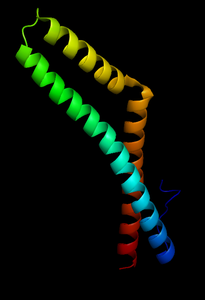Occludin
| Occludin | ||
|---|---|---|

|
||
| Structure of the C-terminus of occludin PDB 1XAW | ||
|
Existing structural data: 1XAW |
||
| Properties of human protein | ||
| Mass / length primary structure | 55.9 kDa | |
| Identifier | ||
| Gene name | OCLN | |
| External IDs | ||
Occludin (from Latin occludere , German: to close ) is a protein that, together with the proteins of the claudin family, is involved in the formation of tight junctions , which occur in epithelial cells . Tight junctions close the cell gaps in the epithelia and protect the body from dehydration as well as from external influences (e.g. from the acidic contents of the stomach with a pH between 1 and 2). Mutations in OCLN - gene are the cause of the rare Aicardi-Goutières syndrome .
discovery
Occludin was first described in 1993 by the research group led by Mikio Furuse and Shoichiro Tsukita . They fractionated extracts from chicken liver and found a protein with a molar mass of 55.9 kDa , which consisted of 504 amino acids . The hydrophilicity plot strongly reminded the scientists of the protein connexin (also four transmembrane domains near the N terminus ).
construction
Occludin is a transmembrane protein with four transmembrane domains, which is why it can be divided into five different domains (each interrupted by a transmembrane domain) which are called AE. As a result, the protein has two extracellular loops, both of which are roughly the same size (45 amino acids each), a short intracellular loop that connects the two extracellular loops, and two long chains at the N and C terminus. The two extracellular loops are necessary to maintain the function (cell-cell connection) and one of them seems to play a role in the localization of occludin in the tight junctions . The E domain (near the C-terminus ; see figure) is located in the cytoplasm and is necessary to bind the protein ZO -1. In a study with mice, Simon Bamforth and co-workers showed that a mutated occludin that lacks the N-terminus and the extracellular domains is still transported to the tight junctions , but can no longer perform its function there and the tight junctions become more permeable .
Up to now (2005) five different types of occludin (types I to IV) and occludin 1B have been found which result from different splicing of the mRNA. This could indicate that several proteins with similar properties (as with the claudins) could form an occludin protein family.
Interactions
The first interaction partners of occludin were determined to be ZO-1 and ZO-2. The protein ZO-3, which also interacts with occludin, was identified later. It is believed that ZO-1 binds directly occludin and this with the actin - cytoskeleton connects. Occludin interactions with JAM, VAP-33, JEAP and CLMP were also found. In addition, occludin is very likely to be phosphorylated by protein kinase C (PKC), which then changes the distribution and function of the protein in the cell (the phosphorylated form appears to be the active form). Furthermore, Ras -like G proteins such as RhoA and Rac-1 could play a role in the regulation of occludin, and cytokines could also play a role in the regulatory process.
swell
- ^ A b c Gemma J. Feldmana, James M. Mullinb, Michael P. Ryan: Occludin: Structure, function and regulation. In: Adv Drug Deliv Rev . 57 (6), Apr 25, 2005, pp. 883-917. PMID 15820558
- ↑ M. Furuse, T. Hirase, M. Itoh, A. Nagafuchi, S. Yonemura, S. Tsukita, S. Tsukita: Occludin a novel integral membrane protein localizing at tight junctions. In: J Cell Biol . 123 (6 Pt 2), Dec 1993, pp. 1777-1788. PMID 8276896
- ↑ SD Bamforth, U. Kniesel, H. Wolburg, B. Engelhardt, W. Risau: A dominant mutant of occludin disrupts tight junction structure and function. In: J Cell Sci. 112 (Pt 12), Jun 1999, pp. 1879-1888. PMID 10341207
- ↑ J. Mankertz, JS Waller, B. Hillenbrand, S. Tavalali, P. Florian, T. Schoneberg, M. Fromm, JD Schulzke: Gene expression of the tight junction protein occludin includes differential splicing and alternative promoter usage. In: Biochem Biophys Res Commun . 298 (5), Nov 15, 2002, pp. 657-666. PMID 12419305
- ↑ Z. Muresan, DL Paul, Goodenough DA: occludin 1B, a variant of the tight junction protein occludin. In: Mol Biol Cell. 11 (2), Feb 2000, pp. 627-634. PMID 10679019